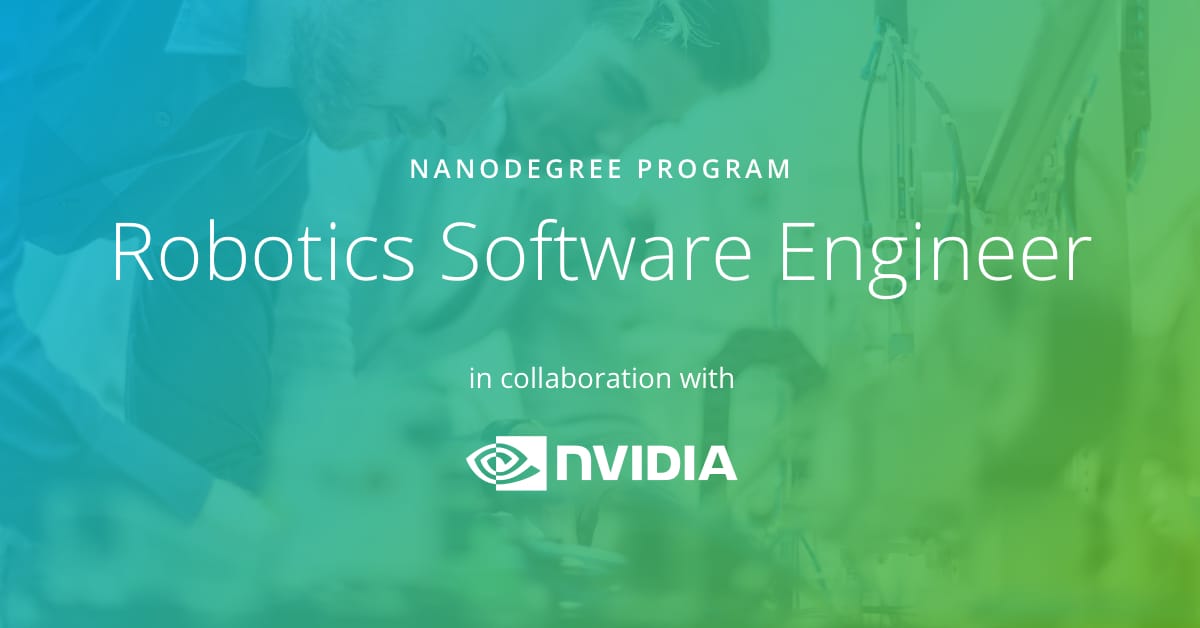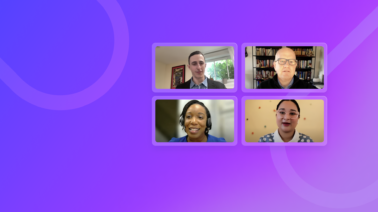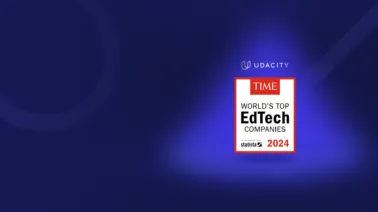Find the right nanodegree program for you.
Start Learning
Udacity welcomes NVIDIA as a new robotics curriculum partner and introduces an education discount for the Jetson TX2!

Teaching robotics is one of the most exciting, inspiring, and challenging endeavors we are currently engaged in. The space is constantly evolving, new innovations emerge with dazzling frequency, and the range of potential applications grows ever wider and more remarkable.
Creating, maintaining, and advancing a curriculum that mirrors in every way the dynamism of this space is both our passion and our mission, and to consistently achieve our goal of ensuring that every student masters the most valuable and most cutting-edge skills, we strive to be agile enough to leverage and incorporate new opportunities virtually the moment they appear.
Introducing NVIDIA
Exactly this kind of opportunity recently materialized, and we are now thrilled to introduce the NVIDIA Deep Learning Institute (DLI) as a curriculum partner for Term 2 of our Robotics Software Engineer Nanodegree program!
“The NVIDIA Deep Learning Institute and Udacity share a common vision—to provide students with hands-on training and challenging curriculum to accelerate their careers. We’re working with Udacity to build a world-class AI and deep learning program so that students can go on to become leading developers, researchers and academics in a variety of fields.” —Greg Estes, Vice President of Developer Programs, NVIDIA
Few companies have generated as much excitement as has NVIDIA in 2017. Earlier this year, when MIT published their “50 Smartest Companies List,” NVIDIA took the #1 spot. Additionally, the company was featured in a New York Times article entitled: “Why a 24-Year-Old Chipmaker Is One Of Tech’s Hot Prospects”:
“The company’s chips—known as graphics processing units, or GPUs—are finding homes in drones, robots, self-driving cars, servers, supercomputers, and virtual-reality gear. A key reason for their spread is how rapidly the chips can handle complex artificial intelligence tasks like image, facial and speech recognition.”
Not only is NVIDIA DLI collaborating with Udacity to build the groundbreaking curriculum for our Robotics Software Engineer Nanodegree program, NVIDIA is making possible a remarkable new hardware opportunity for our students!
NVIDIA Jetson TX2
Artificial Intelligence is at the core of today’s robotics revolution, and NVIDIA Jetson TX2 is the ideal platform for developing real-world applications with real-time AI performance.
On March 7, 2017, an article on the NVIDIA developer blog introduced the Jetson TX2, and described it with these words:
“Jetson TX2’s unparalleled embedded compute capability brings cutting-edge DNNs and next-generation AI to life on board edge devices.”
Through our partnership with NVIDIA, eligible Udacity students will receive an education discount upon enrolling in Term 2 of the program that can be applied to the purchase of an NVIDIA Jetson TX2 Developer Kit. Students who posses the Jetson TX2 will have the opportunity to integrate AI and unparalleled embedded compute capability into their learning experience.
Imagine what students can achieve with this kind of computing power at their disposal!
Curriculum Summary
With NVIDIA onboard, we are able to deepen and refine our Term 2 curriculum. We are able to leverage the cutting-edge expertise of a global leader in the field to deliver our students an unrivaled learning experience. We are able to bring into laser-sharp relief the path students will take as they advance towards robotics mastery. And we are able to fully prepare our students for rewarding careers in this incredible space.
- In Term 1, you’ll establish the necessary software skills to tackle a wide range of robotics challenges. You’ll master core skills and concepts within environments that simulate the physics of real hardware, and solve problems using ROS, Python, and deep learning with TensorFlow.
- In Term 2, you’ll explore curriculum developed in collaboration with NVIDIA DLI. Advanced techniques and their implementations will be covered in depth, and the NVIDIA Jetson TX2 Developer Kit will be introduced. Students who possess the Jetson TX2 will receive supplemental guidance for implementing the new advanced techniques on the hardware platform. There is no requirement to purchase the Jetson TX2 Developer Kit. Students continuing on with the simulation environment will master these same advanced techniques in simulation. Over the course of Term 2, you’ll continue to gain experience with ROS, learn localization and SLAM in C++, and use reinforcement learning for robotics with PyTorch.
Let’s now look at our curriculum in detail!
Curriculum Details: Robotics Software Engineer Nanodegree Program, Term 2
Course 0: Term 2 Introduction
In this course, you’ll get an introduction to Term 2, and explore hardware commonly used in robotics. You’ll learn the uses of common sensors, and which ROS packages you need to support them. Those students with Jetson TX2 hardware will learn how to set up the system and interact with external hardware.
Course 1: Robotics Systems Deployment
In this course, you’ll learn new tools, and the embedded workflow as you move from code on a host system to code on a target system. You’ll work through a familiar problem with these new tools, then extend what you’ve learned in a project.
Project 1: Robotic Inference
Design your own robotic system using inference. You will create a project idea, collect your own data set for classification, and justify network design choices based on your analysis of accuracy and speed on the target system.
Course 2: Localization
The localization problem is the problem of estimating a robot’s pose relative to a known map of the environment. In this course, you will learn classic localization algorithms including Extended Kalman Filter (EKF) localization and Monte Carlo Localization (MCL).
Project 2: Where Am I?
You will use the Monte Carlo Localization algorithm in ROS in conjunction with sensor data and a map of the world to estimate a mobile robot’s position and orientation so that your robot can answer the question “Where am I?”
Course 3: SLAM
Learn how to create a Simultaneous Localization and Mapping (SLAM) implementation with ROS packages and C++. You’ll achieve this by combining mapping algorithms with what you learned in the localization lessons.
Project 3: Map My World Robot
Simultaneous Localization and Mapping (SLAM) can be implemented a number of ways in robotics depending on the sensors used via various ROS packages that exist. Here, you will use a ROS SLAM package and simulated sensor data to create an agent that can both map the world around it and localize within it.
Course 4: Reinforcement Learning for Robotics
In this course, you’ll first learn how to build a basic end-to-end reinforcement learning agent, termed a deep Q-network (DQN). You’ll then enhance it to create a more complex agent that can pick and place from visual input.
Project 4: RL Pick and Place Robot
Build an RL agent to pick, grip, stack, and pack, using a manipulator arm.
Course 5: Path Planning and Navigation
Begin by learning classic path planning algorithms, then compare that with path planning and obstacle avoidance self-reinforcement with DL vision primitives. Finally, combine this with the SLAM you already learned to create a robot agent that maps its world and navigates through it!
Project 5: Home Service Robot
You’ve already used probabilistic methods with SLAM to map and localize a robot. You’ve also designed deep RL engines to solve end-to-end sense-to-action problems, which can now be applied to navigation. In this project, you’ll combine both AI paradigms to build a home service robot that can map, localize, and navigate to perform household tasks, moving from one room to another autonomously.
World-Class Partners, World-Class Experience
The partnerships we form with innovative companies form the backbone of our Nanodegree model. From building cutting-edge courses to establishing valuable hiring relationships, we work with the best and brightest leaders and innovators on the planet to ensure you’re getting a world-class learning experience at all times, and we make a promise to every Udacity student that we will work to connect your learning experience to rewarding career opportunities in your chosen field.
The addition of NVIDIA to our Robotics Software Engineer Nanodegree program—and the opportunity to integrate the Jetson TX2 Developer Kit into the Term 2 curriculum experience through the education discount—means you’re learning at the true leading edge of what is arguably the most important technology of our time. Students of this program will go on to occupy the jobs of the future, and to define the future of AI and robotics.
Are you ready to become a Robotics Software Engineer? Apply today!



